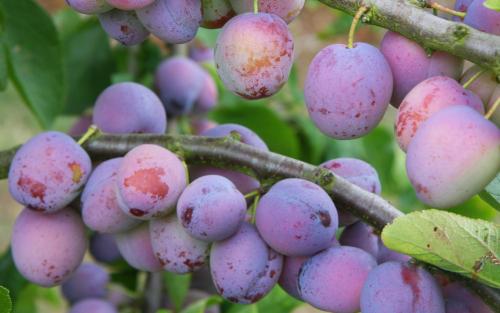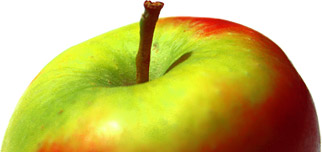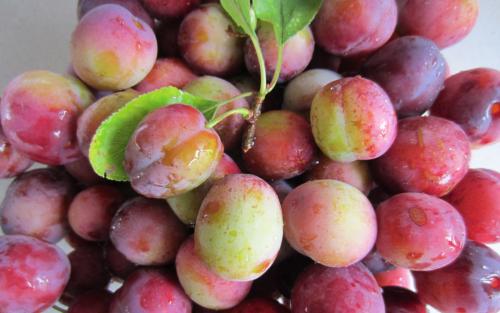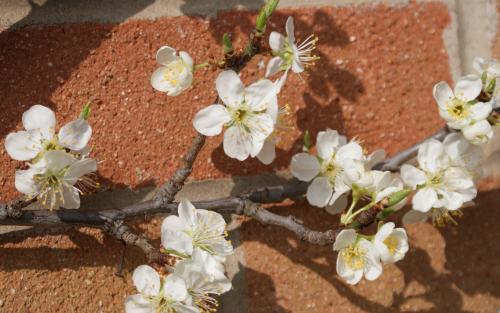
Opal is probably the best-flavoured early plum variety - indeed it is sometimes called a gage-like plum thanks to the excellence of its flavour. It demonstrates (along with Ariel) that crossing a gage with plum can improve the gage-like flavour.
However the flavour depends crucially on developing sugars during the short growing period, and in the UK and northern Europe Opal really benefits from being grown against a south-facing wall or in a sunny aspect. In less favourable situations it will still give good crops but the flavour may be bland.
The fruit is medium-sized, coloured dusky red with a heavy bloom, becoming blue when overripe. The fruit is at its best just before the colour changes to blue. The plums ripen over a period of about 1-2 weeks, so you don't have to deal with a glut. The flesh is straw-yellow and fairly juicy. Opal is a free-stone plum - the stone falls away easily from the flesh. If picked on a warm July day and placed in a fruit bowl Opal also has a wonderful aroma.
Recommended because it is easy to grow in a variety of climates and provides good quality plums early in the season - but to get the full flavour it is essential to thin the crop, and to plant in a sunny aspect.
Opal plum identification images
All images copyright Orange Pippin unless otherwise stated.
USDA identification images for Opal
The identification paintings in the USDA Pomological Watercolor Collection span the years 1886 to 1942.
Citation: U.S. Department of Agriculture Pomological Watercolor Collection. Rare and Special Collections, National Agricultural Library, Beltsville, MD 20705.
Parents and other ancestors of this variety
- Oullins Gage (parent)
Visitor reviews
- 17 Aug 2013 United KingdomA very good early plum, moderately heavy crop this year. Gage genes definitely show through in the flavour. Not as badly affected by brown rot as some
- 21 Oct 2012 EDINBURGH, United KingdomHad this in the garden for 4 years and the fruit just doesn't seem to ripen here. I've just picked the few plums we have and it's 20th october and they are still hard! I'm afraid I'm going to have to take it out. I used to have a Victoria which was fantastic, will stick to that if I decide to plant another in the future.
- 09 Aug 2011 HAMPSHIRE, United KingdomI bought a tree 2 years ago, and it has just produced its first fruit. They are dark purple and fall off while still hard; after being in a bowl with some bananas they are just about edible, but are still rather tart and don't have a nice flavour at all - not what I was expecting. I am very disappointed.
- 23 Sep 2010 IDAHO, United StatesI've grown Opal for 17 years--in Washington State, Minnesota, and now Idaho. Fruit can keep up to a month, in my experience. Ripening date was about July 28 in WA State, about Aug. 2 in MN, about July 25 here. The tree is very precocious. It's one of the very few European plums that will survive and ripen in Anchorage, Alaska where it ripens about Sept. 4 on the average. The tree is fully hardy at -33F, will be injured at -40F but bounces back well from cold injury. Tree has a dense, round head. One minor drawback is its tendency to grow current season growth with very narrow angles between the shoots. It's an excellent plum for the early market, and I'm very fond of it; and it can easily be dried as well.
Tree register
United Kingdom
- Adam Frost in
- Alan Boyer in Bourne, LINCOLNSHIRE
- Alan Sullivan in Preston, LANCASHIRE
- Alice in Barnstaple, DEVON
- Anja Britton in NOTTINGHAMSHIRE
- Anthony Payne in Bath,
- Barbara Woodbine in Huntingdon, CAMBS
- Benz Kotzen in London, LONDON
- Billy Auger in Hopton Wafers, SHROPSHIRE
- Brian Ingram in Burgess Hill, WEST SUSSEX
- Christine Woolass in Goole, YORKSHIRE
- Colin P Dolding in Hanley Castle, WORCESTERSHIRE
- Dan in Uxbridge, MIDDLESEX
- Graham Jackson-Pitt in Arkholme, LANCASHIRE
- Graham Johns in Liverpool, MERSEYSIDE
- Graham Silcocks in Hatherop, GLOUCESTERSHIRE
- Ian Crook in Edinburgh, LOTHIAN
- Iryna in London,
- Jacqueline Lawrence in Milford Haven, PEMBROKESHIRE
- Janet in St Austell, CORNWALL
- Jean Lippett in Martock, SOMERSET
- Joy Lucas in Saddleworth, LANCASHIRE
- Kathryn Cooper in BROMESWELL, SUFFOLK
- Liz Robins in Kidderminster,
- Lorena Fernandez in Bristol, NORTH SOMERSET
- Marian Fitch in Street, SOMERSET
- Mark Davies in Saddleworth, YORKSHIRE
- Maureen Wright in Eyemouth, BERWICKSHIRE
- Maxine Gohari in Stourbridge, WEST MIDLANDS
- Michael Adams in Halifax, WEST YORKSHIRE
- Mrs Stephanie Bond in Stourton Caundle, DORSET
- Mrs Tricia Pursey in Redditch, WORCESTERSHIRE
- Nickkk in Oldham, LANCASHIRE
- Nicola Kirkpatrick in Howden, EAST YORKSHIRE
- Peter Downes in SHILBOTTLE, NORTHUMBERLAND
- Peter Radmore in Port Talbot, SOUTH WALES UK
- Philip Wray in Andover, HAMPSHIRE
- Rachel Wilcox in Wakefield, WEST YORKSHIRE
- Ramesh in London,
- Richard Borrie in York, YORKSHIRE
- Robert Barnes in South Norwood, LONDON
- Roy in Coventry, WARWICKSHIRE
- Sally in DERBYSHIRE
- Scott in Edinburgh,
- Victoria Birkett in Aberdeen, SCOTLAND
- Vincent Bentley in Montgomery, POWYS
- Warren in Glasgow, STRATHCLYDE
- Wayne Seagate in KINGS LYNN, NORFOLK
- Will Davenport in Crowborough, EAST SUSSEX
Denmark
- Bent Ransborg in Langaa, JYLLAND
- Hanne Olsen in Copenhagen,
- Mat Cashmore in Roskilde,
Ireland
- Chris in Cork, CORK
- James Munro in Westport, COUNTY MAYO
- Simon Clarke in Duleek, COUNTY MEATH
- Ute Bohnsack in Kilfenora, CLARE
Italy
- Sarah in Fiesole, TUSCANY
Netherlands
- Bas Cretskens in Stevensweert, LIMBURG
- Karel in Alem,
Poland
- Richard in Krakow,
Spring blossom records for this variety
2014 season
- 26th April 2014 - tree owned by Hanne in Copenhagen, Denmark
2013 season
- 28th April 2013 - tree owned by Richard in York, United Kingdom
2012 season
- 7th April 2012 - tree owned by Karel in Alem, Netherlands
- 30th March 2012 - tree owned by Roy in Coventry, United Kingdom
- 28th March 2012 - tree owned by Mrs Tri in Redditch, United Kingdom
- 28th March 2012 - tree owned by Simon in Duleek, Ireland
- 26th March 2012 - tree owned by Richard in York, United Kingdom
2011 season
- May 2011 - tree owned by Hanne in Copenhagen, Denmark
- 9th April 2011 - tree owned by Dan in Uxbridge, United Kingdom
- 5th April 2011 - tree owned by Karel in Alem, Netherlands
- 4th April 2011 - tree owned by Richard in York, United Kingdom
- 26th March 2011 - tree owned by Roy in Coventry, United Kingdom
2010 season
- 24th April 2010 - tree owned by Richard in York, United Kingdom
Record your blossom dates in our Fruit Tree Register - more >>.
Harvest records for this variety
2017 season
- 4th week June 2017 - tree owned by Brian in Burgess Hill, United Kingdom
2013 season
- 3rd week August 2013 - tree owned by Richard in York, United Kingdom
2012 season
- 3rd week July 2012 - tree owned by Richard in York, United Kingdom
2011 season
- 3rd week August 2011 - tree owned by Roy in Coventry, United Kingdom
- 1st week August 2011 - tree owned by Hanne in Copenhagen, Denmark
- 1st week August 2011 - tree owned by Ute in Kilfenora, Ireland
- 3rd week July 2011 - tree owned by Richard in York, United Kingdom
- 2nd week July 2011 - tree owned by Karel in Alem, Netherlands
Origins
- Species: Prunus domestica - European plum
- Parentage: Oullins Gage and Early Favourite
- Originates from: Sweden
- Introduced: 1925
- Developed by: Horticultural Research Station, Alnarp
Identification
- Awards: RHS AGM (current)
- Country of origin: Sweden
- Period of origin: 1900 - 1949
- Fruit colour: Red
- Flower colour: White
- Leaf colour: Green
- Popularity: Best sellers
- Annual cycle: Deciduous
Using
- Cling-stone: Semi-freestone
- Picking season: Early
- Keeping (of fruit): 1-3 days
- Flavour quality: Very good
- Cropping: Heavy
- Fruit persistence: Ripens over a period
- Food uses: Eating fresh
- Picking period: mid-July
- Wildlife: RHS Plants for Pollinators
Growing
- Gardening skill: Beginner
- Flowering group: 3
- Pollinating others: Average
- Vigour: Slightly large
- Bearing regularity: Regular
- Organic culture: Suitable
- Attractive features: Attractive fruit
- Self-fertility: Self-fertile
Climate
- Cold hardiness (USDA): Zone 4 (-34C)
- Climate suitability: Temperate climates
- Summer average maximum temperatures: Cool ( 20-24C / 68-75F)
- Summer average maximum temperatures: Warm (25-30C / 76-85F)
- Cold hardiness (RHS): H6 (to -20C)
- Summer average maximum temperatures: Cold (< 20C / 67F)
Other qualities
- Disease resistance: Good
Where to buy trees
The following tree nurseries offer Opal plum trees for sale:
- Orange Pippin Fruit Trees (USA) United States
Opal plum trees - Orange Pippin Fruit Trees (UK) United Kingdom
Opal plum trees
Where to buy fresh fruit
The following orchards grow Opal:
United States
Massachusetts
- Brook Farm Orchard, Ashfield
United Kingdom
England - midlands
- Walsgrove Farm, Worcester
England - north
- Saddleworth Orchard, Saddleworth
References
- Fruit Expert
Author: Hessayon



